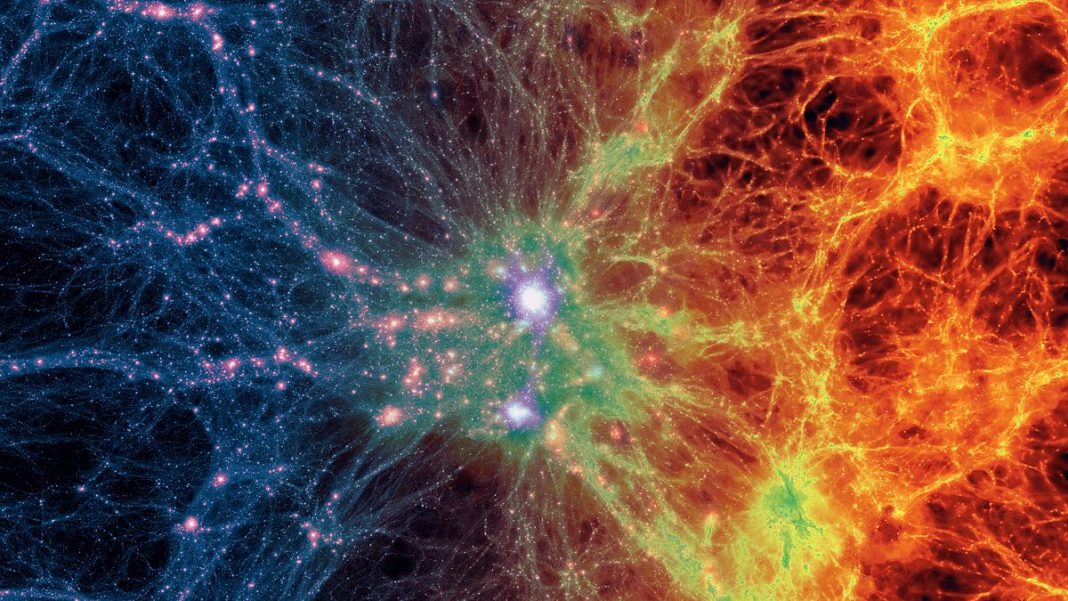Scientists have finally FOUND the universe’s ‘missing matter’,
After 10 years of searching, scientists have finally found the universe’s ‘missing matter’.
For our cosmological models to work, scientists know there should be a certain amount of matter – the substance that makes up everything we can see – out in the universe.
The problem is that only a third of this matter has ever been seen, while the rest is missing.
Now, experts from the European Space Agency say they may have solved the mystery.
They believe the ‘missing’ matter lies in a vast filament of 10-million-degree gases stretching across the depths of the universe.
At over 23 million light-years in length, this cosmic ribbon contains 10 times as much matter as the Milky Way.
The enormous thread connects four galaxy clusters, each containing thousands of individual galaxies filled with billions of stars.
‘It seems that the “missing” matter may truly be lurking in hard-to-see threads woven across the universe,’ said co-author Dr Norbert Schartel, a project scientist on the European Space Agency’s (ESA) XMM-Newton telescope.
The filament stretches diagonally away from Earth as part of the Shapley Supercluster – a collection of 8,000 galaxies which is one of the biggest structures in the universe.
The thread is so long that travelling its length would be like crossing the Milky Way end-to-end more than 230 times.
As its gases collapse inwards under gravity, they produce vast amounts of energy which causes the gas to become extremely hot.
However, because the gas is so spread out, filaments only give out a very faint light which is hard to distinguish from that of nearby galaxies and black holes.
Lead researcher Dr Konstantinos Migkas, of the Leiden Observatory in the Netherlands, told MailOnline: ‘Throughout this thin, diffuse, low-emitting gas, there are many supermassive black holes that emit a lot of X-ray radiation, overcrowding the signal from the filaments and their gas.
‘It’s like trying to see a candlelight next to 10 luminous flashlights from 100 meters away.’
Without being able to isolate the light coming from the gas itself, astronomers haven’t been able to work out how much of the universe’s hidden mass it contains.
In a new paper, published in the journal Astronomy and Astrophysics, astronomers have managed to do this for the very first time using two powerful X-ray telescopes.
The researchers combined observations from the ESA’s XMM-Newton and the Japan Aerospace Exploration Agency’s (JAXA) Suzaku X-ray space telescopes.
While Suzaku mapped out gas’ faint X-ray radiation over a large area, XMM-Newton was able to pinpoint sources of contaminating X-rays such as supermassive black holes.
Co-author Dr Florian Pacaud, of the University of Bonn, says: ‘Thanks to XMM-Newton we could identify and remove these cosmic contaminants, so we knew we were looking at the gas in the filament and nothing else.’
For the first time ever, that has allowed scientists to work out the properties of a cosmic filament.
The exciting part for scientists is that these observations confirm that their models of the universe were correct all along.
Dr Migkas says: ‘From cosmological, large-scale structure simulations that resemble the universe, we see that this still-missing matter should reside in these strings of gas and galaxies and this matter also should have a certain temperature and density.
‘In our study, we confirm for the first time unambiguously that indeed, there are cosmic filaments with exactly the right density and temperature of the gas, as predicted by our current model of cosmology.’
That is a very good indication that the large-scale structure of the local universe does look like scientists’ predictions suggest.
In addition to revealing a previously unseen thread of matter running through the universe, these findings show galaxy clusters are connected over vast distances.
That means some of the densest, most extreme structures in the universe could be part of a vast ‘cosmic web’.
This is an invisible cobweb of filaments that may underpin the structure of everything we see around us.
Now, we are one step closer to understanding how that network fits together.






